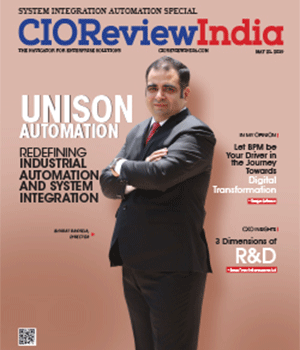
Intelligent Automation as a Business Enabler
Pavan Kota Subramanya, Director – Intelligent Automation, Fiserv Global Services | Friday, 20 May 2022, 15:43 IST

In this age of digital disruption, as every enterprise is striving to stay ahead, technology remains at the forefront of business operations. Intelligent automation (IA) has revolutionized the technology market and can give an edge to organizations that utilize it effectively. Combining artificial intelligence (AI), robotic process automation (RPA) and business process management (BPM) is a necessity for effective IA that drives business results.
According to Everest study, businesses that holistically implement IA solutions can increase business performance and improve strategic goals. The rising popularity of IA is creating opportunities for streamlining operations, optimizing costs, and increasing operational efficiencies. It encompasses advanced analytics, machine learning, computer vision, Natural Language Processing (NLP), and automated training. These innovations have the potential to drastically change the way businesses operate.
Empowering Businesses with IA
Artificial intelligence (AI), robotic process automation (RPA), and business process management (BPM) form the holy trinity of IA, together forming one of its essential components. The amalgamation of complex algorithms and machine learning helps businesses analyze structured and unstructured data to develop predictions. Additionally, AI, when mixed with traditional RPA, which by itself is rule-bound and capable of only handling structured data, enables the ability to process unstructured data, intuitively learn from predictions, adapt in real-time, and manage exceptions. Business workflow automation, the final crucial rung in IA, is an overarching strategy that streamlines everything in the workflow. It helps businesses optimize workflows and gives a long-term return in the form of a well-automated business process plan.
IA for Operational Excellence
Input from data sources such as integrated CRM, IoT, and omnichannel platforms is processed by IA’s underlying capabilities and technologies, resulting in workforce augmentation. Individuals take a long time to digest information manually, which reduces productivity, especially in highly complicated operations. In addition, employees often experience a sense of stagnancy because of repetitive tasks that result in tiresome routines. Automation enables employees to focus on higher-value tasks and enhance productivity. IA is influenced by uniform procedures and techniques, which drive decision-making and ensure a consistent approach to repetitive tasks. In summary, IA eliminates human errors, streamlines processes, provides better experience and accuracy, and enables an enterprise to gain a competitive edge.
Strategizing to Move Beyond Cost Reduction
The growing automation market is focused on immediate cost optimizations delivered by IA solutions, especially in the banking and finance space, thus prioritizing cost optimization as a primary goal.
Compartmentalized RPA installations in separate business processes can deliver quick cost reductions for businesses, but they may not significantly improve business outcomes. Enterprises must establish a long-term automation strategy to employ intelligent automation solutions that combine AI and RPA capabilities to gain a sustained competitive edge.
Implementation of IA for Enabling Growth
For IA to impact business performance, it requires a thriving ecosystem. Adequately surveying data, investing in relevant technologies, and ensuring precise management is key to driving transformation. But determining the ideal automation solution to meet specific business needs can be difficult for businesses. When it comes to sourcing intelligent automation solutions, enterprises often choose one of two ways - a single platform or a combination of point solutions. The former enables easier integration and scalability, and the latter gives more variety concerning a business’s needs. Although both methods meticulously handle potential challenges and can assist an organization in successfully adopting IA, organizations must assess their current automation strength and strategic objectives to choose the best sourcing approach with the most benefits for business.
Enterprises that plan to implement IA will be best positioned to achieve the desired strategic impact. Businesses should be mindful of key components for the successful deployment of IA. For example, understanding the distinction between a tactical and a strategic focus on automation adoption, aligning intelligent automation plans with the digital strategy, and ensuring the necessary data and infrastructure capacity.
CIO Viewpoint
By Steve Brunker, CIO, LSI Industries
By Joel Austin, CIO, Oncor Electric Delivery
How Is IoT Emerging as Next Technology Mega...
By Prashanta Ghoshal, Director - IT Solutions, Geometric Ltd.
CXO Insights
Addressing the Challenges in Logistics Automation
By Janifha Evangeline
Digitalization - the critical enabler for...
By Rajesh Ramachandran, Global Chief Digital Officer - Process Automation & ABB Ability, ABB
Enterprise-wide Approach Needed for...











